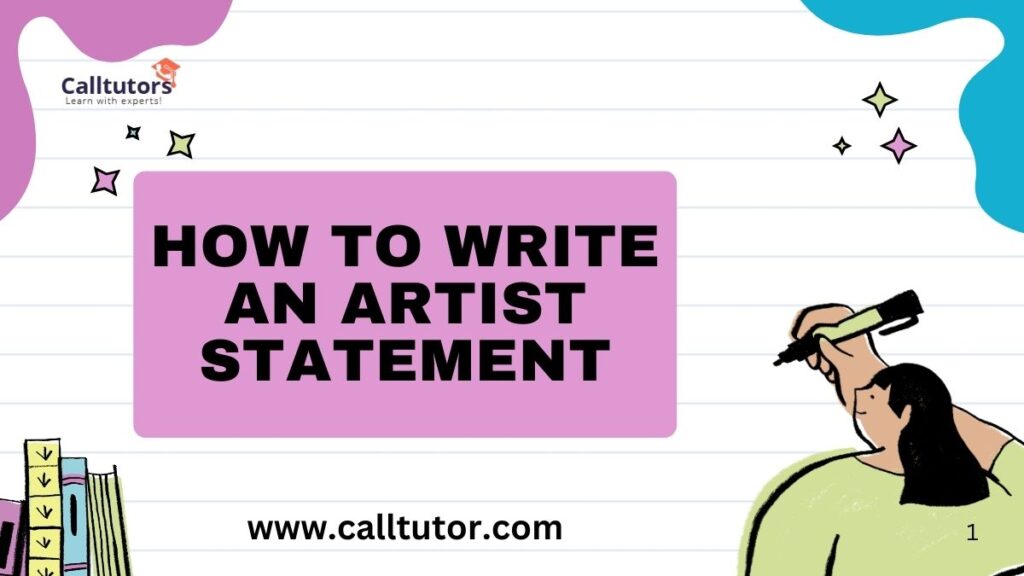An artist statement is one of the most important tools used by artists because it effectively acts as a link between the works and the audience. It gives the public information about you and your art, why you paint, and what you want to achieve through paintings, thus creating an attachment point for some of your pieces. An artist should always ensure he or she has an artist statement for use in exhibitions, a portfolio or any grant application that they wish to use.
This document is not just a procedure and even beyond the canvas, sculpture, and photograph. An artist statement should give the audience the presenter’s personality, inspirations, and as well, the direction of the artist’s work. It can be easily prepared that those who have no clue as to what the artist does can also understand. In this blog, you will read a step-by-step guide on How to Write an Artist Statement.
2. The Purpose of an Artist Statement
Table of Contents
The first and foremost responsibility of an artist’s statement is to provide context to the art that the artist creates. It helps the viewers, critics or prospective buyers to know what you want to communicate through your artistic work. It goes further than just explaining what you do, creates an emotional rapport with the audience and the public and places your work in a continuum, in a culture.
Additionally, an artist’s statement can:
- Artists should explain to gallery owners, curators and collectors what they want to accomplish with their works.
- Extend your message to the elaborate listeners who are not well-versed when it comes to art.
- Be used for interviews, press releases, or even marketing collateral.
In other words, your artist statement is your “voice” where you cannot be there in person to explain your creation.
How to Write an Artist Statement
Step 1: Brainstorming
Before writing, much careful thinking should be given to developing an understanding of one’s art-making.
- What motivation or ideas are behind your work?
- In what way has your background, culture, and or personal experiences affected your art?
- What kind of feelings or thoughts do you wish to incite in your audience?
- What is your ‘tool kit’? Which resources do you use in your practice, and why are they so important?
A mind map or even jotting down notes if you have a lot of things on your mind. This is an important brainstorming stage for finding out what kind of message you would like your statement to convey.
Step 2: Structure Your Statement
A well-structured artist statement has three main parts:
Introduction: Begin with the words greeting and name, and the kind of art you are presenting. Be concise but descriptive. For example:
‘Being a multimedia artist, I design complex environments that are enhanced by technology while built using natural elements to address the conflict between people and nature.’
Body: Explain the main motives, stylistic directions and approaches of your creations. Explain what set your art apart and what you wanted your art to convey. For example:
I use recycled items in most of my work because it is my noble aim to encourage the world to go green. So both rough and polished materials not only make the differentiation between the industrialized society and the natural world comprehensible to the viewers but also force them to think about this difference. In the last series, I have been emphasizing the theme of renewal, where waste objects are changed to something different.
Conclusion: Include a general idea of the theme or objective with your artwork at the end. For example:
That is why my art is about transforming ideas of waste and appearance and knowing that you can find value in the unwanted. The primary purpose of this project is to raise awareness of environmental conservation through art.
Step 3: Revise and Edit
After drafting your statement, take the time to refine it:
- There are no empty words where every sentence must be written for a purpose and to a point.
- Avoid using technical terms where layman’s words can be used.
- One should seek input from others – friends, advisors or colleagues – to take a fresh look at it.
Do’s and Don’ts of Writing an Artist Statement
Do’s:
- Be authentic: Make the statement your own by writing in your style.
- Focus on clarity: Avoid jargon when presenting the results or discussing the topics with both the art context and the broader public.
- Keep it concise: An ideal size for an artist statement is between 150-300 words.
Don’ts:
Be authentic: Make the statement your own by writing in your style.
Focus on clarity: Avoid jargon when presenting the results or discussing the topics with both the art context and the broader public.
Keep it concise: An ideal size for an artist statement is between 150-300 words.
Examples of Strong Artist Statements
Real-world examples can provide inspiration and guidance:
- A photographer might write:
My concern is to reflect the invisible beauty of the decay in big cities. Thus, addressing the bots and cracks, I aim to make a record of memory and obviation, giving the neglected spaces some importance and meaning.
- A ceramic artist could say:
I work mainly with porcelain and make conceptually simple forms that draw more attention to the gaps between them. My work is based on ideas of the traditional Japanese aesthetic, such as wabi-sabi, which embraces the idea of the beauty of the flawed and transient.”
In both cases, all the mentioned criteria can be observed – compactness, concreteness, and emotiveness allowing readers to grasp the main idea of the artist’s activities and his/her goals.
Tips for Standing Out
Add a personal anecdote: If you want to make your statement very interesting and real, telling the story behind the path to creating art or behind a particular piece can help.
Emphasize your unique perspective: Emphasize the differences; one can distinguish by technique, themes, or cultural backgrounds that are reflected in the candidate’s work.
Use vivid imagery: Adjectives can make your statement sexier. For example, replace “I work with colors” with “I use bold, saturated hues to capture the energy of the city.
Common Challenges and How to Overcome Them
Articulating Abstract Ideas: Practical advice when your work is conceptual is not to attempt to explain anything and everything – select one or two ideas to emphasize. Define concrete concepts in terms of other concepts that are easier to image.
Feeling Self-Conscious: In some way, writing in general and when it comes to the work that you’ve done personally can be very daunting. Always remember that it’s your statement piece where you get to express your love and bring other people into your studio.
Keeping It Concise: Stay focused, and don’t lose yourself in unrelated or unessential aspects of your practice. If you have a lot to say, you might write a lengthy version to post on your website and a concise one for exhibitions or applications.
How to Use Your Artist Statement
Once completed, your artist statement becomes a versatile tool:
Exhibitions: Propose it to curators and organizers to provide them with a better picture of what you do.
Portfolio: Include it on profiles or at the bottom of emails with a portfolio to show potential clients or partnering businesses your creative vision.
Website: Share it on your website’s homepage to acquaint people with you or your business.
Media and Marketing: You can use it as a basis for press releases or interviews, for creating promotional material and more.
Always remember to update this statement or rewrite it when your artwork is progressing.
Extended Tips for Writing a Compelling Artist Statement
- Think of Your Audience: Adapt your statement to the audience that is going to read it. For instance, a statement for a gallery exhibition may be slightly different from a statement used while applying for a grant.
- Incorporate Feedback: Once you have composed a statement, you can show it to fellow people or your teachers so they can critique you on it.
- Practice Reading Aloud: Listening to your statement will enable one to know which areas make him or her feel uncomfortable or do not understand well.
Why You Should Revisit Your Artist Statement Regularly
Periodically, your artistic practice changes and your statement should also undergo this change to capture the changes. Set time aside occasionally, annually or after an important project is done in order to reflect and update the portfolio a new.
Conclusion
An artist statement goes beyond a simple explanation of your pieces of art; it is about who you are as an artist. What may seem to be a small gesture of providing your audience with a considered and meaningful message leaves a positive, lasting impression and encourages them to delve deeper into your creative work.
Of course, many of you will recall that your artist statement is a work in progress; it evolves with you. Begin writing today, and do not worry about how it looks or what you need to improve as you go on this journey. This process of self-reflection and rationalization will not only help others present this work in effective ways but also help you better define your artistic mission.



